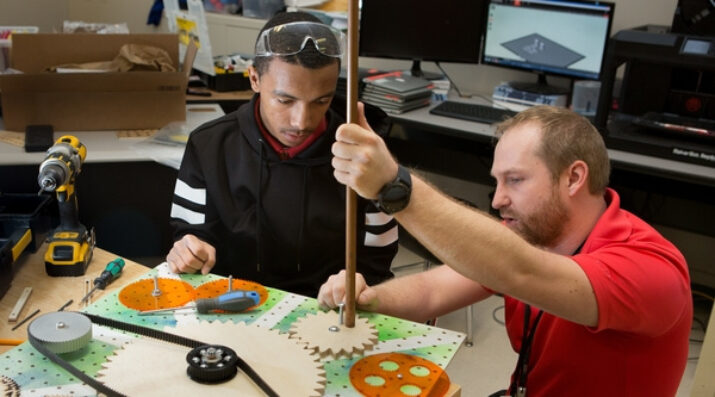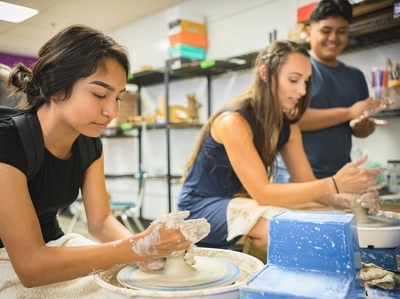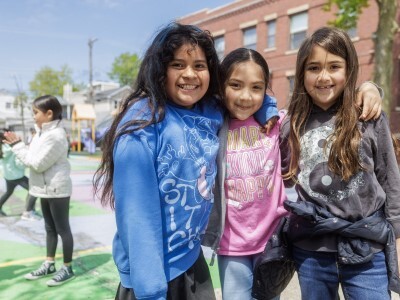Going All-In with Students
Topics

Today’s learners face an uncertain present and a rapidly changing future that demand far different skills and knowledge than were needed in the 20th century. We also know so much more about enabling deep, powerful learning than we ever did before. Our collective future depends on how well young people prepare for the challenges and opportunities of 21st-century life.
If educators are all-in with students, demonstrating empathy and support, how should we set expectations for both behavior and academics?
About a month ago, when people were still allowed to be in the same place at the same time, the faculty at the Workshop School participated in a professional development session on the use of trauma-informed practices in the classroom, part of a major, multi-year effort to better align our systems and classroom practices around the social, emotional, and developmental needs and strengths of our students.
We were talking about how we connect with students in moments of high stress or potential conflict. Almost in passing, the facilitator mentioned that when we need to have these kinds of conversations, we should always try and sit next to the student rather than across from them.
I was aware that nonverbal cues are an important part of trauma-informed communication, but for some reason this simple admonition made me pause, and it has grown in my mind into a larger metaphor for our charge as educators. When are we really alongside our students, and when are we facing them?
Shortly after the workshop (and just before the world shut down), I had the great fortune to spend a couple of days in New Mexico with my friends and colleagues at Future Focused Education. I deeply admire their work and have learned a lot from their experience. But being there, seeing their Leadership Schools and talking to staff and students, the most powerful impression that I was left with was that they are all-in on being alongside their students.
When a student struggles or makes bad choices, the first, second and third responses from adults are all about what’s getting in the way of them being their best self, what supports they need, and what it would look like to do better. There was virtually no discussion of consequences or discipline.
During my time there, I asked several different versions of the question: What do you do when students read your support and empathy as permissiveness? (This is an ongoing challenge for us as a school.)
And I heard several different forms of the same answer: Go harder. Listen more deeply. Reach further into home or community. Search for strengths. Find connections. Make sure they know that you’re all in with them. Walk the talk.
For anyone who got into our line of work because we value and care about young people, this ethic feels right. And yet in practice it gets complicated quickly. Young adults generally want structure even as they push back on it. They want to know what the limits are, and many will push until they run into them. But if the job of the adults is to be alongside them and to build the strongest, deepest relationships possible, where does the accountability come from?
The romantic answer is that if you build strong enough relationships, you won’t need that accountability. This is a corollary to the other fallacy common in progressive education, which is that students only act out because school is boring. Both contain elements of truth, and both will backfire spectacularly if understood naively.
So who sets limits in a student-centered environment? Who enforces consequences when needed? I wish I had a more clear-cut answer to this question. Reflecting on both our strengths and challenges at the Workshop School, my hunch is that the solution includes at least two key elements:
- A set of expectations for both behavior and academics that are simple, clear, and fair, upheld and supported by schoolwide systems operating consistently and transparently throughout the organization.
- A commitment by adults in the school to uphold the expectations within those systems as dispassionately as possible.
The norms we set with and for students should be something that teachers can observe alongside them. “This is what we need from you. How can I help you get there?” Instead of negotiating rules or consequences, teachers should be able to coach students toward the norms and expectations we’ve agreed to.
All of this assumes that our norms focus on the right things, and that students play a central role in shaping, defining, and explaining them. It assumes that discipline is not about punishment (or worse, power) but about clarity, safety, and commitment to shared values. And it assumes that those in charge of schoolwide systems can and will uphold them consistently and fairly. None of that is easy.
Even if we get all of those things right, this is no picnic for teachers and other student-supporting staff. Being a youth ally and an advocate means having skin in the game: our success depends on someone else’s actions, and building close relationships requires risk taking from all parties. It makes us adults vulnerable. It means that we can’t let the daily frustrations and challenges calcify into protective armor, even as our own survival instincts tell us that’s what we should do. It means being willing to confront our own baggage. And above all, it means putting in the work. Trust is built through action more than words.
This is asking a lot from both systems and people. There’s no easy path here. But as I sit sheltered at home, four weeks removed from the thrum of school, it feels like the right one.
Photo at top courtesy of Allison Shelley/The Verbatim Agency for American Education: Images of Teachers and Students in Action.




